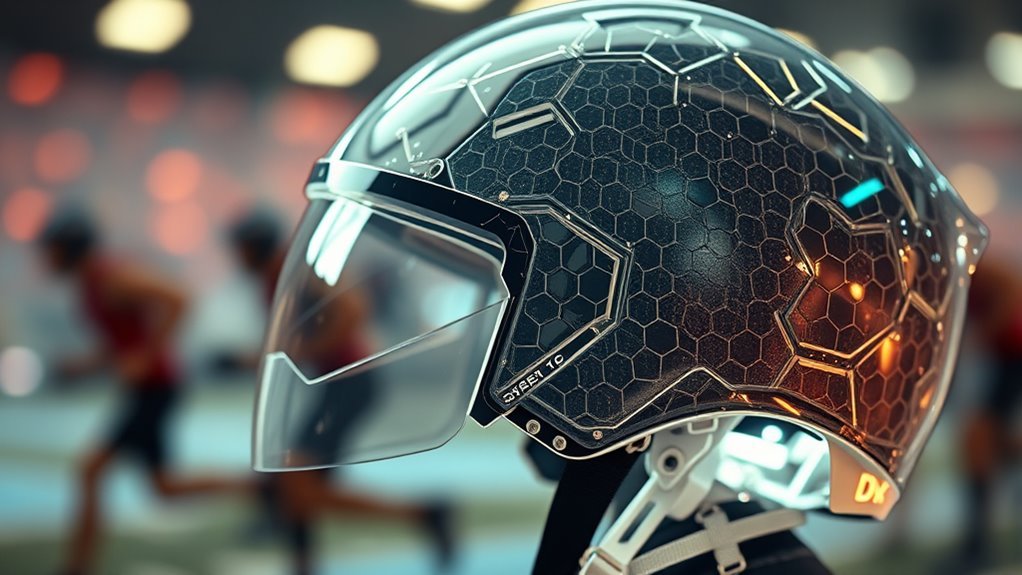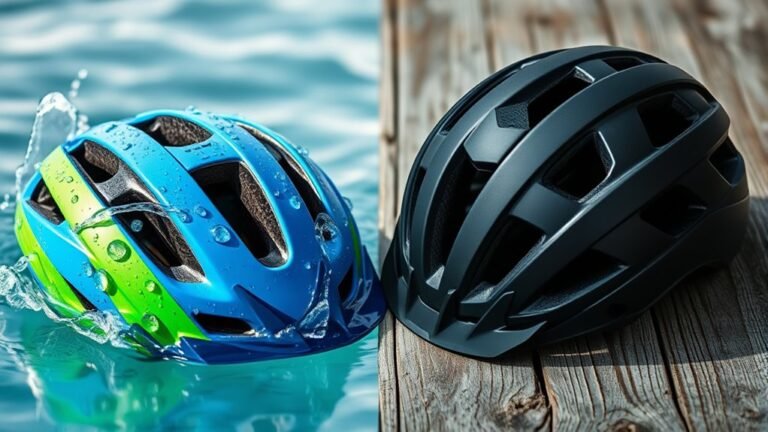The Future of Lightweight Helmet Materials
The future of lightweight helmet materials focuses on advanced composites and innovative polymers that enhance both safety and comfort. By utilizing carbon fiber and bio-based materials, manufacturers improve strength-to-weight ratios while promoting sustainability. Enhanced impact resistance and energy absorption techniques are vital for preventing traumatic brain injuries. Additionally, features like superior breathability and moisture management elevate user experience. As these technologies evolve, further developments in helmet design and functionality will shape the industry’s landscape.
The Importance of Lightweight Helmets in Safety Gear

While you might not think about it often, the weight of a helmet can greatly impact your safety and comfort during use. A lighter helmet considerably enhances user experience, allowing for prolonged wear without fatigue. When evaluating safety performance, helmet weight is essential; a balance between protection and comfort is key. Heavier helmets can restrict movement and increase the risk of injury during an accident due to neck strain. Conversely, lightweight helmets can improve situational awareness and agility, ultimately enhancing your freedom of movement. By focusing on lightweight designs, manufacturers are prioritizing safety without compromising performance. As a result, understanding the implications of helmet weight is important in selecting the most effective safety gear for your needs.
Advances in Composite Materials

Recent innovations in carbon fiber technology have greatly enhanced the strength-to-weight ratio of helmet materials. Additionally, the development of bio-based composites offers a sustainable alternative without compromising performance. These advancements are vital for improving safety while maintaining comfort and functionality in lightweight helmets.
Carbon Fiber Innovations
As advancements in composite materials continue to evolve, carbon fiber has emerged as a game-changer in the development of lightweight helmets. Its unique attributes, such as exceptional strength-to-weight ratio and superior carbon fiber durability, make it an ideal choice for high-performance applications.
| Property | Benefit | Carbon Fiber Application |
|---|---|---|
| Strength | High impact resistance | Racing helmets |
| Weight | Lightweight for increased agility | Sports and recreational helmets |
| Flexibility | Customizable shapes | Industrial safety helmets |
| Thermal Stability | Maintains integrity under heat | Firefighter helmets |
| Cost | Decreasing production costs | Commercial helmets |
These innovations in carbon fiber applications not only enhance safety but also empower users, providing them with the freedom to perform at their best.
Bio-Based Composites Development
With the rising demand for sustainable materials, bio-based composites are gaining traction in helmet development, offering an eco-friendly alternative to traditional materials. These composites utilize bio-based fibers, such as hemp, flax, or jute, which provide comparable strength and lightweight properties to synthetic options. Additionally, they contribute to lower carbon footprints during production, aligning with environmental sustainability goals. The integration of these fibers not only enhances the mechanical performance of helmets but also promotes biodegradability, reducing long-term waste. As researchers refine the processing techniques and bonding methods, you’ll find that the performance metrics of bio-based composites increasingly meet the rigorous safety standards demanded in helmet design. Embracing these innovations allows for a future where safety and environmental benefits coexist.
Innovative Polymer Technologies

In exploring innovative polymer technologies, you’ll find significant advancements in composite structures that enhance helmet performance. These materials not only improve impact resistance but also incorporate sustainable innovations that align with environmental considerations. Understanding these developments can lead to more effective and responsible helmet design.
Advanced Composite Structures
Although traditional materials have long dominated helmet design, advanced composite structures utilizing innovative polymer technologies are revolutionizing the industry. You’ll find that these materials not only enhance performance but also provide greater design freedom. By leveraging composite manufacturing techniques, manufacturers can achieve structural optimization that traditional materials simply can’t offer.
- Lightweight properties improve comfort during extended use.
- Enhanced design flexibility allows for aerodynamic shapes.
- Superior durability guarantees longevity in harsh conditions.
- Tailored mechanical properties meet specific performance requirements.
These advancements enable you to enjoy a helmet that feels lighter, fits better, and ultimately enhances your experience, whether you’re riding a motorcycle or playing sports. Embracing these technologies is key to the future of head protection.
Impact Resistance Enhancements
Advanced composite structures have paved the way for significant improvements in impact resistance through innovative polymer technologies. The integration of advanced polymers allows helmets to absorb and dissipate energy more effectively during impact testing. Utilizing materials like thermoplastic elastomers and nanocomposites enhances flexibility while reducing weight, providing you with both comfort and safety. These materials resist material fatigue better than traditional options, guaranteeing durability over time without compromising performance. By combining high-energy absorption capabilities with low-density designs, modern helmets can now meet rigorous safety standards while maintaining user freedom. As you push boundaries in various activities, these enhancements ensure that your helmet remains reliable, protecting you against potential impacts without sacrificing agility or comfort.
Sustainable Material Innovations
As the demand for environmentally friendly products increases, the helmet industry is embracing sustainable material innovations that leverage cutting-edge polymer technologies. These advancements focus on integrating recycled materials and implementing eco-friendly processes, ensuring helmets are not only lightweight but also ethically produced.
- Enhanced durability through bio-based polymers
- Lower carbon footprint with recycled composites
- Improved performance using innovative eco-friendly coatings
- Compliance with stringent environmental regulations
Impact Resistance and Energy Absorption
When selecting lightweight helmet materials, understanding impact resistance and energy absorption is crucial for guaranteeing safety and performance. You need to evaluate how different materials handle impact dynamics, which directly affects their ability to protect against head injuries. Advanced composites, foams, and other innovative materials can enhance energy dissipation upon impact, reducing the forces transmitted to your skull. For instance, materials with high tensile strength and elasticity can deform under stress, allowing for effective energy absorption. This not only mitigates the risk of traumatic brain injuries but also guarantees that the helmet remains lightweight and comfortable. Ultimately, choosing the right material will empower you with both freedom and security, allowing you to pursue your passions with confidence.
Breathability and Comfort Features
While safety is paramount, the breathability and comfort of lightweight helmet materials greatly enhance user experience during prolonged wear. Effective moisture management and advanced ventilation systems are essential features that guarantee peak airflow, keeping you cool and dry. With a focus on user-centric design, these materials can greatly reduce discomfort and fatigue.
- Integrated moisture-wicking liners to absorb sweat.
- Adjustable ventilation systems for personalized airflow.
- Lightweight designs that minimize pressure points.
- Ergonomic shapes that conform to individual head profiles.
Sustainability in Helmet Material Production
Although the demand for lightweight helmets continues to grow, manufacturers are increasingly focused on sustainability in helmet material production. You’ll find that many companies are now integrating recycled materials into their designs, greatly reducing their environmental impact. By utilizing these materials, they not only minimize waste but also promote a circular economy. Eco-friendly production methods are being prioritized, ensuring that the entire manufacturing process—from sourcing to final assembly—aligns with sustainable practices. This shift not only meets consumer demand for responsible products but also enhances the overall performance of helmets. As you consider your choices, it’s essential to support brands that commit to sustainability, which ultimately contributes to a healthier planet without compromising on safety or functionality.
Future Applications in Various Industries
As the demand for lightweight helmets expands, their applications are poised to penetrate various industries beyond traditional sports and military use. The versatility of advanced materials positions them for significant impact in sectors like automotive, aerospace, and construction. You’ll see innovations that enhance safety without adding weight.
- Automotive applications: Lightweight helmet technology can improve driver safety in electric vehicles.
- Recreational gear: Sports equipment, including cycling and motorcycle helmets, will benefit from these advancements.
- Aerospace technology: Helmet materials can enhance pilot safety and comfort.
- Construction safety: Lightweight designs will revolutionize safety gear, ensuring better protection for workers.
These developments promise to redefine safety standards across multiple industries, enhancing freedom while maintaining protection.
Regulatory Standards and Safety Testing
When developing lightweight helmets, adhering to regulatory standards and conducting rigorous safety testing is essential to guarantee their effectiveness and reliability. You’ll need to verify regulatory compliance with established safety standards, such as those set by organizations like the Consumer Product Safety Commission (CPSC) and the American National Standards Institute (ANSI). These standards dictate impact resistance, penetration, and retention system performance. Testing involves subjecting helmets to various impact scenarios to simulate real-world conditions. By implementing thorough safety testing protocols, you can validate your helmet’s design and materials, ensuring they meet or exceed these safety benchmarks. Ultimately, prioritizing regulatory compliance not only enhances user safety but also fosters trust in your product, allowing users the freedom to choose gear that protects them effectively.
The Role of Research and Development in Innovation
While the helmet industry continues to evolve, the role of research and development (R&D) in driving innovation is essential. You’ll find that advancements in material science and design engineering are at the forefront of creating lightweight helmets that enhance safety and comfort. R&D not only fosters creativity but also guarantees that new materials meet stringent safety standards.
- Development of advanced composite materials for improved impact resistance
- Integration of smart technologies for enhanced user experience
- Exploration of sustainable materials to minimize environmental impact
- Collaboration between engineers and scientists to accelerate innovation
Frequently Asked Questions
What Are the Most Common Lightweight Materials Used in Helmets Today?
The most common lightweight materials used in helmets today are carbon fiber and aramid fibers. Carbon fiber offers exceptional strength-to-weight ratios, making it ideal for high-performance helmets. Aramid fibers, like Kevlar, provide excellent impact resistance and durability. Both materials help reduce overall helmet weight while maintaining safety standards. By utilizing these advanced materials, manufacturers can create helmets that enhance comfort and mobility, giving you the freedom to perform at your best.
How Do Lightweight Helmets Compare to Traditional Helmets in Terms of Protection?
When you’re cruising down the road on your bike, you want a helmet that offers both comfort and protection. Lightweight helmets often outperform traditional models regarding impact resistance, meeting stringent safety standards while reducing fatigue. For instance, a rider wearing a modern lightweight helmet may experience less strain during long rides compared to a bulkier option, allowing for better focus and freedom. Ultimately, you gain enhanced safety without sacrificing comfort.
Can Lightweight Helmets Be Customized for Different Sports or Activities?
Yes, lightweight helmets can definitely be customized for different sports or activities. You can achieve a custom fit that enhances comfort and safety. By tailoring the design to sport-specific requirements, like additional ventilation for cycling or reinforced areas for impact in football, you guarantee peak performance. This level of customization allows you to enjoy the freedom of movement while maintaining the necessary protection, making lightweight helmets a versatile choice for various athletic pursuits.
What Is the Average Lifespan of a Lightweight Helmet?
A lightweight helmet typically lasts around 3 to 5 years, but remember, “an ounce of prevention is worth a pound of cure.” To extend its lifespan, follow helmet maintenance tips like regular inspections for cracks and ensuring proper storage. Always refer to helmet replacement guidelines, especially after significant impacts or when it shows signs of wear. Prioritizing these practices not only enhances safety but also gives you the freedom to enjoy your activities confidently.
How Do Manufacturers Ensure the Quality of Lightweight Helmet Materials?
Manufacturers verify the quality of lightweight helmet materials through rigorous quality control processes and extensive material testing. They evaluate each component’s performance under various conditions, examining factors like impact resistance and durability. By employing advanced testing techniques, they can identify potential weaknesses and make necessary adjustments. This meticulous approach not only guarantees the helmets meet safety standards but also provides you with confidence in their reliability, allowing you to enjoy freedom without compromise.






